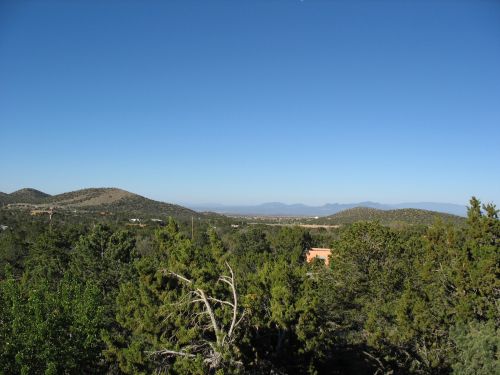
Foothills of Sangre de Cristo Mountains
When the Spanish first entered what is now the southwestern United States in the sixteenth century, they found a very different pattern of population density and distribution from that prevailing during Chacoan times five hundred years earlier. While the heartland of the pueblo world during the Chacoan era had been the southern Colorado Plateau, which had a large population loosely grouped into low-density communities with smaller populations on its fringes shading into the surrounding culture areas, at Contact only a handful of highly aggregated pueblos were left on the plateau and the majority of the population was concentrated in huge sites in one of the former fringe areas, the Rio Grande valley.
So what happened? In some ways that is the key question confronting southwestern archaeology, and so far it has proven remarkably intractable. Five hundred years is a long time. A lot can change in a period like that, and in this case a lot did. In addition to the obvious changes of population aggregation and migration, there were a lot of more subtle but no less important changes in other aspects of culture such as architecture, pottery, and (apparently) ritual practices which make it surprisingly difficult to trace any given group of people through this complicated series of events. While it’s clear from the overall continuities in culture that the ancient Puebloan people as a whole were the ancestors of the modern Pueblos as a whole, it’s been practically impossible to connect any particular ancient group to any particular modern one. The combination of large-scale movement and massive societal change has significantly obscured the details of the story.

Kiva Road in Santa Fe, New Mexico
This series of changes is the main overall topic of The Prehistoric Pueblo World, and the various geographic areas covered by its chapters include both those that ended up being abandoned by their inhabitants and those that ended up being where those people went when they left. So far in this series of posts we’ve discussed most of the “destination” regions, including Hopi, Zuni, Acoma, and the Rio Abajo. In this one we tackle what is probably the most important, and in some respects the most difficult to understand: the northern Rio Grande (or “Rio Arriba”).
This region is the subject of chapter 13 of the book, written by Patricia Crown, Janet Orcutt, and Timothy Kohler. Crown is a prominent archaeologist at UNM who has published on a wide variety of southwestern topics; most recently she is known for her discovery of chocolate on ceramics at Chaco Canyon, a breakthrough that is likely to significantly alter understandings of the Chaco Phenomenon. Orcutt and Kohler are more known for their work in the Mesa Verde region. All, however, have done significant amounts of work on the northern Rio Grande, and they do an excellent job here of summarizing the information available on the various subregions. In a pattern that is becoming very familiar, the quantity and quality of available information on those subregions varies widely, but to the extent that information is available the trends in each are strikingly similar.

Sangre de Cristo Mountains, Chimayo, New Mexico
What’s most remarkable about this region, especially given its fertile nature and high population at Contact, is that it was extremely sparsely populated until the thirteenth century. All of the regions show a continual increase in aggregation through time, and all except the rather unusual Gallina area (which patterns more with areas to the west) show huge increases in population between 1250 and 1350. Given the very low populations before this time, it seems overwhelmingly likely that most of this population increase is due to immigration, sometimes of entire communities which seem to appear fully formed in some areas. Since many other regions were being abandoned at this same time, it seems pretty clear where the people were coming from in a general sense, but as always specific connections are elusive.

Sign for Santa Fe County Road 46
In addition to the issue of migration, which the authors present as primary in understanding developments in this area, the accompanying trend toward ever-increasing aggregation cries out for explanation. This is always a difficult process to explain, but the authors offer some tentative suggestions, noting the apparent uniformity of the trend throughout the region and suggesting that environmental change is likely a factor. Another factor, and not necessarily an unrelated one, is increasing competition and conflict, which could be expected to increase along with population density, which in turn is linked to environmental conditions and available resources. In some subregions there is considerable evidence for warfare and defensive concerns, which some have proposed as the main impetus for aggregation. The fact that aggregated communities seem to grow in place in some areas and be imported whole in others certainly suggests that the reasons, whatever they were, for concentrating communities were regional rather than local, and the related factors of environmental change and increasing conflict do potentially meet that criterion.
In the end, the spotty nature of the data makes firm conclusions elusive, and the purpose of this book is in part to present the data now available and spur efforts to gather more. This chapter fulfills those roles nicely.

Jemez Electric Pole in Chimayo, New Mexico
Leave a comment